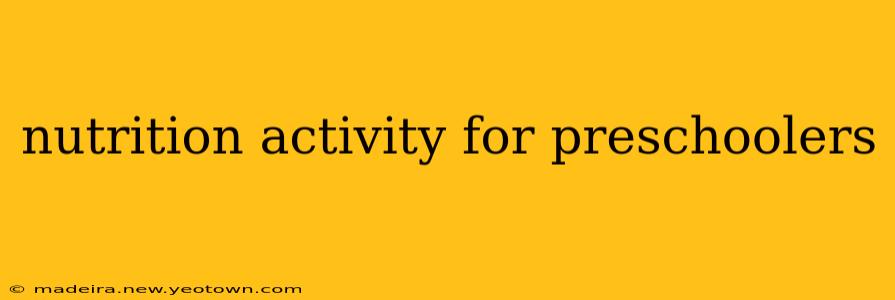Preschool is a time of incredible growth and development, both physically and mentally. Nourishing little bodies with the right nutrients is crucial for their energy levels, cognitive function, and overall well-being. But getting preschoolers excited about healthy eating can sometimes feel like a marathon, not a sprint! This isn't just about what they eat, but how they learn about it. Let's explore engaging and educational nutrition activities that will make healthy eating fun for your preschoolers.
What are some fun ways to teach preschoolers about healthy eating?
Teaching preschoolers about nutrition doesn't have to be a lecture. Think interactive games, sensory experiences, and creative projects that transform learning into playtime. We'll explore several methods throughout this post, catering to different learning styles. Remember, the goal is to build positive associations with healthy foods and foster a lifelong love of nutritious eating.
How can I make mealtimes more enjoyable for my preschooler?
Mealtimes should be happy and relaxed, not battlegrounds. Here are some tips to make mealtimes more enjoyable:
- Involve them in the process: Let your preschooler help with age-appropriate tasks like washing vegetables, setting the table, or even stirring ingredients. This gives them a sense of ownership and makes them more invested in the meal.
- Make it colorful and fun: Arrange food attractively on their plates. Use cookie cutters to create fun shapes from sandwiches or fruits.
- Offer choices: Don't force them to eat everything, but offer a variety of healthy options and let them choose what they want to eat.
- Be a role model: Children learn by observing. If they see you enjoying healthy foods, they're more likely to try them too.
- Positive reinforcement: Praise their efforts and focus on the positive aspects of trying new foods, rather than dwelling on refusals.
What are some healthy snack ideas for preschoolers?
Snack time is a great opportunity to sneak in extra nutrients. Here are some healthy and appealing options:
- Fruits and vegetables: Offer a variety of colorful fruits and vegetables, such as berries, grapes, banana slices, carrot sticks, and cucumber slices.
- Whole-grain crackers: Look for crackers made with whole grains and minimal added sugar.
- Yogurt: Choose plain yogurt and add fruit or a drizzle of honey for sweetness.
- Hard-boiled eggs: A great source of protein.
- Cheese cubes: Provides calcium and protein.
What are some age-appropriate nutrition activities for preschoolers?
Let's dive into some engaging activities that bring nutrition to life:
1. Taste Test Adventure:
Blindfold your preschooler (with adult supervision!) and let them guess different fruits and vegetables based on taste and texture. This enhances their sensory awareness and encourages exploration of new flavors.
2. MyPlate Creations:
Use a paper plate and cutouts of different food groups (fruits, vegetables, grains, protein, dairy) to create their own personalized "MyPlate." This visually reinforces the concept of balanced meals.
3. Grow Your Own Food:
Start a small herb garden or grow some easy-to-cultivate vegetables like radishes or cherry tomatoes. Watching plants grow from seeds instills appreciation for where food comes from.
4. Healthy Food Collage:
Gather pictures from magazines or printouts of healthy foods. Let your preschooler create a collage representing their favorite nutritious meals or snacks.
How can I make learning about nutrition fun for my preschooler?
The key is to make it playful and experiential. Instead of lectures, focus on activities that engage their senses and imagination. Remember to celebrate their efforts and successes, focusing on the joy of discovery rather than strict adherence to dietary guidelines. By making healthy eating a positive and enjoyable experience, you are setting the stage for a lifetime of nutritious habits.

